Biology Chapter 2
Topic: NUTRITION - Eating for Health
Hello Students!
Today we learn about the food we eat (chikafu). Why do we need to eat? What kinds of food are best for us? Let's find out how food keeps us alive and well.
What is a Balanced Diet?
(Kuti Kudya Kwakaringana zvimbonyatsoreveyi?)
- Our bodies need different things from food to work properly. They need energy, materials to grow and repair, and things to protect us from sickness.
- Different foods give us different things.
- Some foods give lots of energy (like sadza, bread, rice).
- Some foods help build our bodies (like meat, beans, eggs).
- Some foods protect us (like fruits and vegetables - muriwo nemichero).
- A Balanced Diet means eating the right amounts of different kinds of food so that our body gets everything it needs.
- It's like building a strong house: you need bricks, cement, water, wood, roof sheets – not just one thing! Your body needs different types of food to be strong and healthy.
Think of your plate: A good meal often has:
- Some energy food (sadza, rice, potatoes).
- Some building food (relish with beans, meat, fish, eggs, nuts).
- Some protecting food (muriwo - green vegetables, tomatoes, onions, maybe a fruit).
The Components (Parts) of a Balanced Diet and Their Jobs
(Zvikamu ZveBalanced Diet neMabasa Azvo)
A balanced diet contains these main parts, called nutrients:
1. Carbohydrates (Makabhohaidhiretsi)
- Job: Gives us ENERGY for everything we do (walking, working, playing, even thinking!). This is our main fuel.
- Foods: Sadza (from maize meal), rice, bread, potatoes, sweet potatoes (mbambaira), cassava (mufarinya), sugar, pasta.
2. Proteins (Mapuroteni)
- Job: Needed for GROWTH and to REPAIR our body (like fixing cuts or building muscles). Very important for children, pregnant women, and healing.
- Foods: Beans (nyemba), groundnuts (nzungu), meat (nyama), chicken (huku), fish (hove), eggs (mazai), milk (mukaka), kapenta, madora/mopane worms.
3. Fats / Lipids (Mafuta)
- Job: Gives ENERGY (even more than carbohydrates, but used as a store), keeps us WARM, protects organs, helps absorb some vitamins. We only need a small amount.
- Foods: Cooking oil, fat on meat (type yemafuta anobuda pa pork ichangopera mvura mupoto), butter, margarine, avocado (yes mavhoko ane mafuta), nuts (nzungu).
4. Vitamins (Mavitamini)
- Job: Needed in small amounts to keep us HEALTHY and protect us from diseases. Each vitamin has a special job (e.g., Vitamin A for eyesight, Vitamin C for skin and fighting colds).
- Foods: Fruits (michero like mangoes, oranges, guavas), vegetables (muriwo like spinach, rape, carrots, tomatoes), milk, eggs.
5. Minerals (Mamirinerari)
- Job: Needed in small amounts for strong bones and teeth (Calcium), healthy blood (Iron), and many other body functions.
- Foods: Milk (Calcium), meat (Iron), green leafy vegetables (muriwo) (Iron, Calcium), salt (Sodium, Iodine if added).
6. Fibre / Roughage (Mafibha)
- Job: Not digested for energy, but helps food move through our stomach and intestines easily. Helps prevent constipation (kuoma dumbu).
- Foods: Whole grains (like whole maize meal), beans, vegetables (muriwo), fruits (michero).
7. Water (Mvura)
- Job: ESSENTIAL FOR LIFE! Needed for blood, digestion, sweat (cooling down), removing waste, almost everything the body does.
- Foods: Drinking water, fruits, vegetables, milk, soup, maheu.
Key Idea: We need ALL these components in the right balance for good health.
Planning a Balanced Meal for Different Groups
(Kuronga Chikafu Chakakwana Kuvanhu Vakasiyana e.g vana vacheche, vanhukadzi vakazvitakura/anoyamwisa, murwere, chembere vanotofanha kupihwa chikafu chakasiyana siyana)
Different people need slightly different amounts or types of food based on their age, activity, or condition.
- Growing Child:
- Needs: Lots of Protein (for growth), Calcium (for strong bones/teeth - from milk, kapenta), and Energy (Carbs) for playing.
- Example Meal: Sadza, beans or kapenta, muriwo, a glass of milk or a fruit.
- Pregnant or Breastfeeding Woman:
- Needs: Extra Protein, Iron, Calcium, Vitamins, and Energy to support herself and the baby. Needs a very nutrient-rich diet. (nutrient rich zvinoreva kuti anofanha kudya chikafu chine type yese yema nutrients not kungoti sadza nenyama everyday anofana kudya netuma fruits, mukaka, ma avho chichii)
- Example Meal: Sadza, chicken or fish, muriwo with added groundnut butter (muriwo une dovi), fruit like mango or orange, milk.
- Person Doing Hard Physical Work (e.g., Farmer, Builder):
- Needs: Lots of Energy (Carbohydrates) to fuel the work. Also needs good amounts of Protein to maintain muscles. (mabhiridha anoda chikafu chinovapa power coz vanenge vachisimudza zvitinha so panoda power, munovapa sadza nekagubhu kemaheu voenda)
- Example Meal: Large portion of sadza, generous serving of meat or beans, muriwo, maybe maheu for extra energy and hydration.
- Old Person (Elderly-vana gogo nana sekuru vachembera):
- Needs: May need less energy if not very active, but still needs enough Protein (to prevent muscle loss), Calcium (for bone health), Vitamins, and Minerals. Food might need to be softer and easy to digest.
- Example Meal: Porridge (bota) with milk/groundnuts, soft cooked chicken or fish, well-cooked muriwo, mashed sweet potato, fruit like banana.
- Sick Person / Recovering from Illness:
- Needs: Extra Protein for repair, Vitamins (especially C) to fight infection, easy-to-digest foods, and plenty of Water.
- Example Meal: Chicken soup with vegetables, soft porridge, boiled egg, fruit juice (if available), lots of water.
The idea is to adjust the amounts and focus on certain nutrients based on the person's specific needs, but always aiming for a balance.
What is Malnutrition?
(Kuti Malnutrition Chii?)
- "Mal" means bad or wrong. So, Malnutrition means bad nutrition.
- It happens when a person's diet does not contain the right amount of nutrients.
- It can mean two main things:
- Under-nutrition: Not getting enough food or nutrients overall. This leads to being underweight, weak, tired, and children may not grow properly (stunting).
- Imbalanced Nutrition: Getting enough energy (calories) but not enough of the important building or protecting nutrients (like protein, vitamins, minerals). Someone might even be overweight but still be malnourished because they eat too much unhealthy food and not enough healthy food.
- Malnutrition makes people weak and more likely to get sick.
Deficiency Diseases
(Zvirwere Zvinokonzerwa neKushomeka kweNutrients)
- Deficiency means a lack or shortage of something.
- A Deficiency Disease is a sickness caused by not having enough of a specific vitamin or mineral in the diet over a long period.
- The body needs these nutrients for specific jobs, and if they are missing, those jobs can't be done properly, leading to illness.
Causes of Deficiency Diseases:
- Poor Diet: Not eating foods that contain the needed vitamin or mineral. This is the most common cause. (e.g., eating only sadza without relish or vegetables for a long time).
- Poverty: Not being able to afford or get access to a variety of foods.
- Lack of Knowledge: Not knowing which foods are important for health.
- Poor Food Availability: Certain foods might not grow well or be available in a particular area or season.
- Problems with Digestion: Sometimes the body cannot absorb the nutrient from the food properly, even if it's eaten (this is less common).
(Examples of deficiency diseases include Scurvy - lack of Vitamin C, Rickets - lack of Vitamin D/Calcium, Goitre - lack of Iodine, Anaemia - lack of Iron, Kwashiorkor - lack of Protein).
Testing Foods for Nutrients (Simple Tests)
(Kuedza Chikafu Kuti Tione kuti mune Nutrients here)
Scientists and students can do simple tests in a lab (or classroom) to find out which nutrients are present in a food sample. You usually need the food sample (often crushed or ground and mixed with a little water) and some special chemicals called reagents.
1. Test for Starch
- Nutrient: Starch (a type of carbohydrate)
- Chemical Used: Iodine solution (usually brownish-yellow or brown)
- How: Add a few drops of Iodine solution to the food sample.
- Positive Result (Starch IS Present): The food sample turns Blue-Black or very dark purple/black.
- Negative Result (Starch IS NOT Present): The colour stays brownish-yellow.
(Foods like sadza, bread, potato would test positive)
2. Test for Simple Sugars (Reducing Sugars like Glucose)
- Nutrient: Simple Sugars (like glucose, found in fruits, honey)
- Chemical Used: Benedict's solution (usually blue)
- How: Add Benedict's solution to the food sample (in liquid form or mixed with water) in a test tube. Heat the test tube gently in a beaker of warm water (water bath). Be careful when heating!
- Positive Result (Simple Sugar IS Present): The blue solution changes colour to Green, then Yellow, then Orange, and finally Brick-Red (like red bricks) if there is a lot of sugar. Any of these colour changes (except blue) means sugar is present.
- Negative Result (Simple Sugar IS NOT Present): The solution stays blue.
(Foods like fruit juice, honey would test positive)
3. Test for Protein
- Nutrient: Protein
- Chemical Used: Biuret Reagent (This is often made by adding two chemicals: Sodium Hydroxide solution first, then a few drops of Copper Sulfate solution - which is blue). Or you might use a ready-made Biuret solution.
- How: Add Sodium Hydroxide solution to the food sample (usually liquid). Then add a few drops of Copper Sulfate solution and shake gently. OR add the Biuret solution directly.
- Positive Result (Protein IS Present): The mixture turns Purple or Violet.
- Negative Result (Protein IS NOT Present): The mixture stays blue (or the colour of the food).
(Foods like milk, egg white, bean soup would test positive)
4. Test for Fats / Lipids
- Nutrient: Fats or Oils
- Chemical Used: Ethanol (a type of alcohol) and Water
- How (Emulsion Test):
- Crush the food sample if solid.
- Add some Ethanol to the food sample in a test tube and shake well to dissolve the fat.
- Let any solid settle, then carefully pour the liquid ethanol (which might have dissolved fat in it) into another test tube containing some clean Water.
- Positive Result (Fat IS Present): A Cloudy White mixture forms. This cloudy suspension is called an emulsion.
- Negative Result (Fat IS NOT Present): The mixture stays clear (or just shows the colour of the food extract).
(Foods like cooking oil, groundnuts, fatty meat would test positive)
Let's Summarise (Nutrition)
- A Balanced Diet gives our body all the nutrients it needs (Carbs, Proteins, Fats, Vitamins, Minerals, Fibre, Water).
- Different people (children, workers, pregnant women) have slightly different needs.
- Malnutrition is bad nutrition (too little food, or the wrong kinds).
- Deficiency Diseases are caused by lacking specific vitamins or minerals.
- We can test foods using chemicals (Iodine for starch, Benedict's for sugar, Biuret for protein, Ethanol/Water for fat) to see what nutrients they contain.
Eating well is key to staying healthy, strong, and full of energy!
Let us move on to how our bodies get energy from the food we've eaten. This involves breathing and a process called Respiration.
Topic: RESPIRATORY SYSTEM & RESPIRATION

Hello Students!
We know we need food (like carbohydrates) for energy. But how does our body actually get the energy out of the food? It needs oxygen from the air we breathe! The system that helps us breathe is the Respiratory System (our nose, windpipe, and lungs - mapapu). But the actual process of getting energy inside our body parts is called Respiration.
Important: Breathing (kufema) is the physical act of taking air in and out of the lungs. Respiration is the chemical process inside our cells that uses oxygen to release energy from food. They work together! (musiyano uripo pa breathing ne respiration ndewekuti breathing unenge uchipinza nekubudisa air muma lungs, respiration inoitika mukati menyama dzedu inoshandisa oxygen yapinzwa nekufema iya kuti kuchikafu chatadya chikafu chatadya chitipe energy)
What is Respiration?
- Respiration is a chemical reaction that happens inside the tiny living parts of our body (called cells).
- Its main job is to release energy from our food (mainly a sugar called glucose, which comes from carbohydrates).
- This energy is needed for everything we do: moving, growing, keeping warm, thinking, repairing our body. It's like the body's power supply.
Parts of the Respiratory System
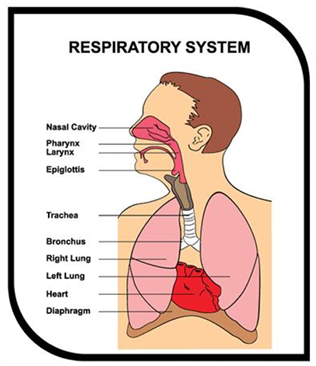
(no need to cram all this –its for your understanding (understand the basic functions))
- Nasal Cavity: This is the space inside your nose. Its job is to warm, moisten, and clean the air you breathe in before it goes down into your lungs.
- Pharynx: This is basically your throat, the part behind your mouth and nasal cavity. It's like a shared passageway for both air going to your lungs and food going to your stomach.
- Larynx: This is your voice box, located in your neck. It contains your vocal cords, which vibrate to make sound when air passes over them. It also helps guide air to the windpipe.
- Epiglottis: This is a small flap of tissue in your throat. Its important job is to act like a lid, covering your windpipe (trachea) when you swallow so food doesn't accidentally go into your lungs.
- Trachea: This is your windpipe. It's the main tube that carries air from your larynx down towards your chest.
- Bronchus (plural: Bronchi): The trachea splits into two main tubes, one going into each lung. These tubes are called bronchi. Their job is to carry air from the trachea into the lungs.
- Right Lung & Left Lung: These are the two main organs for breathing, located in your chest. Their job is to take oxygen from the air you inhale and transfer it into your blood. They also remove waste gas (carbon dioxide) from your blood, which you then exhale.
- Heart: While shown here, the heart is actually the main organ of the circulatory system (blood system), not the respiratory system. It's located between the lungs. Its job is to pump blood. It works with the lungs by pumping blood to the lungs to pick up oxygen and get rid of carbon dioxide, and then pumping that oxygen-rich blood to the rest of the body.
- Diaphragm: This is a large, dome-shaped muscle located below your lungs. It's the main muscle used for breathing. When it contracts and moves down, it helps pull air into your lungs (inhaling). When it relaxes and moves up, it helps push air out of your lungs (exhaling).
There are two main ways respiration can happen:
- Aerobic Respiration: Using Oxygen.
- Anaerobic Respiration: Without using Oxygen.
Let's look at each one.
Aerobic Respiration (Using Oxygen)
- "Aerobic" means "with air" or more specifically, "with oxygen".
- This is the main way our bodies (and most plants and animals) get energy.
- It happens inside our cells all the time, day and night.
- What it needs: It needs Glucose (from food) and Oxygen (from the air we breathe in).
- What it produces: It produces:
- Energy (Simba) - Lots of it! (pakasangana glucose ne oxygen unoita simba risingaiti)
- Carbon Dioxide - A waste gas that we breathe out.
- Water - A small amount, also useful for the body.
- How it connects to breathing: Our lungs (mapapu) breathe in air to get the Oxygen needed for aerobic respiration. Then, the blood carries this oxygen to all the cells. The cells use the oxygen and glucose to make energy, and they produce Carbon Dioxide waste. The blood carries this Carbon Dioxide back to the lungs, and we breathe it out.
- (right! Paunofemera mukati paya urikuisa mhepo muma lungs, mumhepo iyi mune zvinhu zvakasiyana siyana zvausingaone kusanganisira zvinana oxygen ana nitrogen ana carbon dioxide. Pane zviri mumapapu ako zvinokwanisa kuziva kuti iyi iOxygen zvoitora zvoipinza muropa ropa royenda nayo Oxygen iya munyamadzako dzese nyama dzako(cells) ndozvosanganisa oxygen ne glucose rabvamuchikafu kuti uwane simba, kana pakasangana Oxygen + Glucode panobuda = Simba + Carbon Dioxide. Energy yawawana iya unoishandisa kuita chero kana uchifamba inenge ichitoshanda and then Carbon dioxide iya yobva yatorwa neropa yoenda kuma lungs then ndopaya paunoita breathe out. Pazvinozonakidzira ndepekuti this happens nekanguva kadikidikiki.)
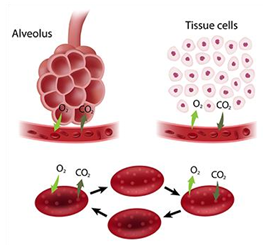
Word Equation for Aerobic Respiration
A word equation is a simple way to show what goes in and what comes out of a chemical reaction.
For Aerobic Respiration, the word equation is:
Glucose + Oxygen → Energy + Carbon Dioxide + Water
Let's break it down:
- Glucose: The food fuel (simple sugar).
- Oxygen: The gas from the air we breathe in.
- (These are the things you START with - Reactants)
- → : This arrow means "reacts to produce" or "changes into".
- Energy: The useful power released for the body to use.
- Carbon Dioxide: The waste gas we breathe out.
- Water: Another product formed.
- (These are the things you END UP with - Products)
Remember: Aerobic respiration releases a large amount of energy from each bit of glucose.
Anaerobic Respiration (Without Oxygen)
- "An-aerobic" means "without air" or "without oxygen".
- This type of respiration happens when there is not enough oxygen available for the cells.
- In Humans: This usually happens in our muscles during very hard, fast exercise (like sprinting - kumhanya zvakanyanya). The muscles work so hard they use up oxygen faster than the blood can supply it. So, they switch to anaerobic respiration for a short time to get some quick energy.
- What it needs: It only needs Glucose. (No oxygen is used).
- What it produces (in human muscles): It produces:
- Energy - Only a small amount compared to aerobic respiration.
- Lactic Acid - A waste product that builds up in the muscles.
- Lactic Acid: This substance makes muscles feel tired, heavy, and sore (kuneta nekuremerwa). When you stop exercising hard and breathe normally again, oxygen becomes available. The body can then break down the lactic acid.
- In Other Organisms: Some tiny organisms, like Yeast (used for making bread rise and brewing beer – kuvidza doro), can do anaerobic respiration all the time if there's no oxygen. They produce different waste products.
- Yeast produces: Energy + Alcohol + Carbon Dioxide. This is called fermentation.
Word Equations for Anaerobic Respiration
There are different equations depending on the organism.
- In Human Muscles (during hard exercise):
Glucose → Energy + Lactic Acid
- Glucose: Food fuel.
- → : Changes into.
- Energy: A small amount released.
- Lactic Acid: Waste product causing muscle fatigue.
- In Yeast (Fermentation):
Glucose → Energy + Alcohol + Carbon Dioxide
- Glucose: Food fuel (sugar).
- → : Changes into.
- Energy: A small amount released.
- Alcohol: The type of alcohol found in drinks.
- Carbon Dioxide: The gas that makes bread rise and beer fizzy.
Let's Summarise (Respiration)
- Respiration releases energy from glucose inside cells.
- Aerobic Respiration:
- Uses Oxygen.
- Produces LOTS of Energy, Carbon Dioxide, Water.
- Equation: Glucose + Oxygen → Energy + Carbon Dioxide + Water
- Anaerobic Respiration:
- Happens Without Oxygen.
- Produces LITTLE Energy.
- In Humans: Produces Lactic Acid. Equation: Glucose → Energy + Lactic Acid
- In Yeast: Produces Alcohol and Carbon Dioxide. Equation: Glucose → Energy + Alcohol + Carbon Dioxide
Understanding respiration helps us see how important breathing is and how our bodies get the power they need from the food we eat!
Now let us explore how things move around in living organisms! We will look at how plants manage their water and how blood travels in our bodies.
Topic: TRANSPORT SYSTEMS
Hello Students!
Just like roads and paths help people and goods move from one place to another, living things also have systems to transport important stuff inside them. Plants need to move water, and animals (like us) need to move blood carrying food and oxygen. Let's learn about these transport systems.
Transport in Plants - Reducing Water Loss (Transpiration)
What is Transpiration?
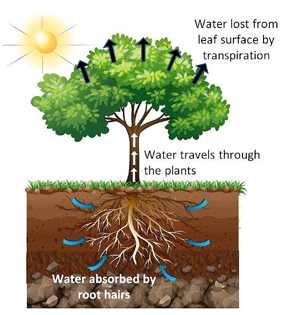
Transpiration is water loss from leaves.
- Remember plants pull water up from the soil through their roots, and it travels up to the leaves. Transpiration is when this water evaporates (turns into vapour/gas) and leaves the plant through tiny holes in the leaves (called stomata). It's a bit like the plant "sweating".
- Why Reduce Transpiration? Plants need water to live. In hot, dry places (like much of Zimbabwe during the dry season), losing too much water through transpiration can be dangerous. The plant could dry out and die. So, plants have special features (adaptations) to help them save water by reducing transpiration.
Adaptations of Leaves to Reduce Water Loss (magadzirirwo akaitamashizha kuti asanyanyo buda mvura yakawanda):
- Thick Waxy Cuticle:

- What it is: A thick, shiny, waterproof layer on the outside of the leaf (like a layer of floor polish).
- How it helps: The wax stops water from evaporating directly through the leaf surface. Many plants in dry areas have a very thick cuticle.
- Small Leaf Surface Area:
- What it is: Having small leaves, or leaves shaped like needles or spines (like in cactus plants, though not common here, but think of some thorny bushes).
- How it helps: Less surface area means fewer stomata overall and less area exposed to the sun and wind, so less water is lost.
- Stomata Mostly on the Lower Surface:
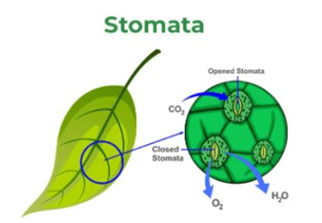
- What it is: Most of the tiny holes (stomata) are found on the underside of the leaf, not the top surface.
- How it helps: The lower surface is usually shadier and cooler, and less windy, which slows down evaporation from the stomata.
- Sunken Stomata:
- What it is: The stomata are located in small pits or grooves on the leaf surface.
- How it helps: These pits trap moist air right next to the stomata. When the air outside the hole is already moist, less water evaporates out from the leaf.
- Hairs on the Leaf Surface:
- What it is: Some leaves have tiny hairs (vhudzi vhudzi) on their surface, especially on the underside.
- How it helps: These hairs also trap a layer of moist, still air close to the leaf surface, reducing wind and evaporation from the stomata. Think of Silver Leaf plants (mutsvubvu).
- Rolled Leaves:
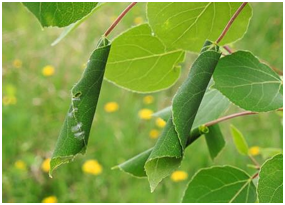
- What it is: Some grasses (like types found in dry mapani) can roll their leaves up during dry times.
- How it helps: Rolling the leaf encloses the stomata inside, trapping moist air and protecting them from wind and sun.
Transport in Humans - The Blood

Our bodies transport things like oxygen, food, and waste using the blood, which travels through tubes called blood vessels.
Functions of Blood (What Blood Does):
Blood is amazing! It has many important jobs:
- Transporting Oxygen: Carries oxygen from the lungs (mapapu) to all parts of the body so our cells can perform aerobic respiration (get energy).
- Transporting Carbon Dioxide: Carries the waste gas, carbon dioxide, from the body cells back to the lungs to be breathed out.
- Transporting Nutrients: Carries digested food parts (like glucose, amino acids) from the intestines to the body cells where they are needed.
- Transporting Waste Products: Carries other waste materials (like urea) from the cells to the kidneys (itsvo) to be removed in urine (mutundo).
- Transporting Hormones: Carries chemical messengers (hormones) from glands to target organs to control various body functions.
- Fighting Disease: Contains white blood cells (maseruraachena) that attack germs (bacteria, viruses) and protect us from sickness.
- Clotting: Contains platelets (maplatelet) and proteins that help the blood to clot (become thick and sticky) when you get a cut, stopping bleeding and forming a scab.
- Temperature Regulation: Helps to spread heat around the body, keeping our temperature steady.
The Blood Vessels (The Pipes for Blood)

Types of Blood Vessels: Artery, Vein, and Capillary.
Blood travels around the body in a network of tubes called blood vessels. There are three main types:
- Arteries: Carry blood AWAY from the heart.
- Veins: Carry blood TOWARDS the heart.
- Capillaries: Tiny vessels that connect arteries and veins and reach every cell.
Structure of Blood Vessels:

- Lumen: The hollow space inside the tube where the blood flows.
1. Arteries:
- Job: Carry blood pumped forcefully from the heart at high pressure. Usually carry oxygen-rich blood (except the pulmonary artery going to the lungs).
- Structure:
- Thick, strong, muscular walls: To withstand the high pressure from the heart pumping.
- Elastic fibres in the walls: Allow the artery to stretch with each heartbeat and then spring back (like elastic), helping to push the blood along.
- Narrow lumen: Helps maintain the high pressure.
- No valves (usually, except near the heart).
2. Veins:
- Job: Carry blood back towards the heart at low pressure. Usually carry oxygen-poor blood (except the pulmonary vein coming from the lungs).
- Structure:
- Thinner walls than arteries (less muscle and elastic tissue) because the pressure is much lower.
- Wider lumen than arteries, allowing easier blood flow at low pressure.
- Valves: Have special flaps inside called valves, especially in the arms and legs. These stop the blood from flowing backwards (due to gravity) and ensure it keeps moving towards the heart.
3. Capillaries:
- Job: Form a huge network (netsiweki) connecting tiny arteries (arterioles) to tiny veins (venules). They reach every part of the body. This is where the important exchange happens: oxygen and nutrients move out of the blood into the cells, and carbon dioxide and waste move from the cells into the blood.
- Structure:
- Extremely thin walls: Only one cell thick! This makes it very easy for substances to pass through quickly between the blood and the body cells.
- Very narrow lumen: So narrow that red blood cells have to squeeze through in single file. This slows down the blood flow slightly, giving more time for exchange.
Differences Among Blood Vessels (Summary)
| Feature | Artery | Vein | Capillary |
|---|---|---|---|
| Direction of Flow | Away from heart | Towards heart | Connects arteries to veins |
| Blood Pressure | High | Low | Very low |
| Wall Thickness | Thick | Thin | Extremely thin (one cell thick) |
| Muscle/Elastic | Lots | Little | None |
| Lumen Size | Narrow | Wide | Very narrow |
| Valves | No (except near heart) | Yes (especially in limbs) | No |
| Main Function | Transport blood quickly under pressure | Return blood to heart, prevent backflow | Exchange of substances between blood & cells |
Let's Summarise (Transport)
- Plants reduce water loss (transpiration) using adaptations like thick cuticles, small leaves, hairy surfaces, or rolled leaves.
- Blood has many jobs: carrying oxygen, CO2, nutrients, waste, hormones, fighting germs, clotting, and controlling temperature.
- Blood travels in vessels: Arteries (thick walls, high pressure, away from heart), Veins (thin walls, low pressure, valves, towards heart), and Capillaries (tiny, thin walls for exchange).
Topic: REPRODUCTIVE SYSTEMS
Hello Students!
Reproduction is how living things create new individuals, continuing life from one generation to the next. Plants and animals have different ways of doing this. Let's start with plants.
Reproduction in Plants
Plants can reproduce in two main ways: Asexual and Sexual. Let Us focus first on Asexual Reproduction.
What is Asexual Reproduction in Plants?
- "Asexual" means "without sex".
- In asexual reproduction, a new plant grows from only ONE parent plant.
- It does not involve flowers, seeds, or the mixing of special cells (gametes) from two parents.
- The new plant is exactly the same as the parent plant – like a perfect copy or a clone.
- It's like taking a piece of the parent plant and it grows into a whole new plant by itself.
Methods of Asexual Reproduction in Plants (How it Happens)
Plants have clever natural ways to reproduce asexually. Sometimes humans also use these methods to grow plants quickly.
Natural Methods:
- Runners (or Stolons):
- What it is: A stem grows sideways along the top of the ground. New roots and shoots grow from points (nodes) along this runner, forming new plants.
- Examples: Strawberry plants, many types of running grass (tsangadzi).
- Rhizomes:
- What it is: A stem grows sideways under the ground. It looks like a root but has buds that can sprout new shoots upwards and roots downwards.
- Examples: Ginger (tsangamidzi), kapinga grass, ferns.
- Tubers:
- What it is: A swollen underground part (usually a stem, like a potato) that stores food. It has "eyes" which are buds that can grow into new plants.
- Examples: Irish Potato (dapiri). (Note: Sweet potato / mbambaira is a swollen root, but also used for asexual reproduction).
- Bulbs:
- What it is: An underground bud with layers of fleshy leaves that store food. A new plant grows from the central bud. Smaller bulbs can form around the main one.
- Examples: Onion, Garlic.
Artificial Methods (Done by Humans):
- Cuttings:
- What it is: A piece of stem or leaf is cut from the parent plant and planted in soil or water. It grows new roots and becomes a new plant.
- Examples: Sugar cane (nzimbe), cassava (mufarinya), many garden shrubs, flowers like hibiscus.
- Grafting and Budding:
- What it is: Taking a piece (a bud or small branch) from one plant and attaching it onto the stem or root of another related plant. Used often for fruit trees to combine good roots with good fruit parts.
- Examples: Improving mango or orange trees.
Advantages of Asexual Reproduction (Why it's Good Sometimes)
- Faster: Usually quicker than growing from seed.
- Only One Parent Needed: No need to find another plant for pollination. Useful if plants are far apart.
- Good Qualities Kept: The new plant is identical to the parent. If the parent plant is strong, healthy, or produces good fruit, the new plants will too. Farmers like this!
- Can Happen in Tough Conditions: Doesn't rely on pollinators (like bees) or good conditions for seeds to sprout.
Disadvantages of Asexual Reproduction (Why it's Not Always Good)
- No Variety: All plants are the same. If a disease attacks, it could kill all of them because none have resistance.
- Overcrowding: New plants often grow close to the parent, leading to competition for sunlight, water, and soil nutrients.
- Can't Adapt: Because all plants are identical, they can't easily adapt if the environment changes (e.g., climate becomes drier).
- Diseases Passed On: If the parent plant has a disease, the new plants will also have it.
Sexual Reproduction in Plants
Now, let us look at the other main way plants reproduce: Sexual Reproduction.
What is Sexual Reproduction in Plants?
- "Sexual" reproduction involves the combining of genetic material from two parents (or two different parts of the same parent plant).
- In plants, this process almost always involves flowers, which contain special male and female reproductive cells called gametes.
- The male gamete (in pollen) and the female gamete (in an ovule) join together in a process called fertilization.
- This fertilization leads to the formation of seeds.
- The new plant that grows from a seed will have a mix of characteristics from both parent parts, making it different from either parent – it introduces variety.
- It’s like two parents contributing to create a unique offspring.
The Key Player: The Flower
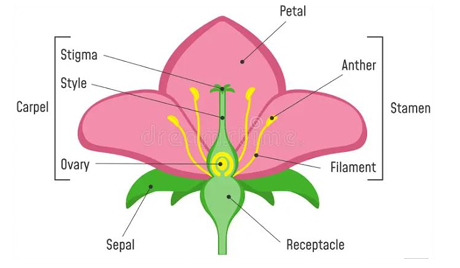
Parts of a typical flower.
Flowers are the reproductive organs of many plants. A typical flower has several important parts, each with a specific job in sexual reproduction:
- Sepals:
- What it is: Usually green, leaf-like structures at the base of the flower.
- Job: To protect the flower bud before it opens.
- Petals:
- What it is: Often brightly coloured and sometimes scented parts of the flower.
- Job: To attract pollinators like insects or birds.
- Stamen (Male Part): Consists of two parts:
- Anther:
- What it is: The top part of the stamen that produces and holds pollen grains.
- Job: Pollen contains the male gametes.
- Filament:
- What it is: A stalk that holds up the anther.
- Job: To position the anther effectively for pollen release.
- Anther:
- Pistil or Carpel (Female Part): Consists of three parts:
- Stigma:
- What it is: The sticky or feathery top part of the pistil.
- Job: To catch and receive pollen grains.
- Style:
- What it is: A tube-like structure connecting the stigma to the ovary.
- Job: Provides a pathway for the pollen tube to grow down to the ovules.
- Ovary:
- What it is: The swollen base of the pistil that contains one or more ovules.
- Job: Ovules contain the female gametes (egg cells). After fertilization, the ovary develops into the fruit, and ovules develop into seeds.
- Stigma:
The Process of Sexual Reproduction in Plants (How it Happens)
Sexual reproduction in flowering plants involves several key steps:
1. Pollination:
- What it is: The transfer of pollen grains from the anther (male part) to the stigma (female part) of a flower.
- How it happens:
- Self-Pollination: Pollen from the anther of a flower lands on the stigma of the same flower or another flower on the same plant.
- Cross-Pollination: Pollen from the anther of a flower on one plant lands on the stigma of a flower on a different plant of the same species. This promotes more variety.
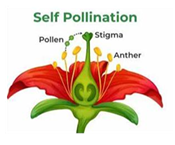
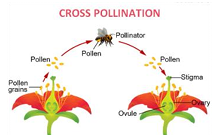
- Agents of Pollination (who or what helps):
- Wind: For plants with small, dull flowers and lots of light pollen (e.g., maize/chibage, grasses).
- Insects (e.g., bees, butterflies): For plants with bright, scented flowers and nectar (e.g., sunflowers, bean flowers).
- Birds (e.g., sunbirds): For plants with often red, tubular flowers and lots of nectar (e.g., aloe, some hibiscus).
- Water: For some aquatic plants.
- Bats: For some night-blooming flowers with strong scents.
2. Fertilization:

- What it is: The fusion (joining) of the male gamete (from the pollen grain) with the female gamete (egg cell in the ovule).
- How it happens:
- After a pollen grain lands on a suitable stigma, it grows a tiny tube called a pollen tube.
- This tube grows down through the style and into the ovary, reaching an ovule.
- The male gamete travels down the pollen tube and fuses with the female gamete inside the ovule.
- This fused cell is called a zygote.
3. Seed and Fruit Formation:
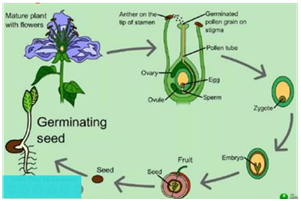
- What it is: The development of the fertilized ovule into a seed and the ovary into a fruit.
- How it happens:
- The zygote (fertilized egg) divides many times and develops into an embryo (the baby plant).
- The ovule develops into a seed, which contains the embryo and a food store, all protected by a tough outer seed coat.
- The ovary (surrounding the ovules) develops into a fruit. The fruit protects the seeds and helps in their dispersal.
- Examples: A mango fruit developed from the ovary, and the mango seed inside developed from a fertilized ovule. A bean pod is the fruit, and the beans inside are the seeds.
4. Seed Dispersal:

- What it is: The spreading or scattering of seeds away from the parent plant.
- Why it's important: To avoid overcrowding and competition for sunlight, water, and nutrients. It also allows plants to colonize new areas.
- Methods of Dispersal:
- Wind: Seeds that are small, light, or have wing-like/feathery structures (e.g., dandelion, jacaranda seeds).
- Water: Seeds that can float (e.g., coconut).
- Animals:
- Edible fruits: Animals eat the fruit, and the seeds pass through their digestive system and are deposited elsewhere (e.g., guava, wild berries).
- Sticky/Hooked seeds: Seeds attach to animal fur or human clothing (e.g., blackjack / utsine).
- Explosion (Self-dispersal): Some fruits dry out and burst open, scattering the seeds (e.g., some bean pods, touch-me-not plants).
5. Germination:
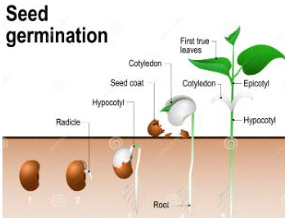
- What it is: The process by which a seed starts to grow into a new young plant (seedling).
- Conditions needed:
- Water: To soften the seed coat and activate enzymes.
- Oxygen: For respiration (to release energy for growth).
- Suitable Temperature (Warmth): For enzymes to work efficiently.
- (Light is not usually needed for germination itself, but is essential once the seedling emerges and starts photosynthesis).
Advantages of Sexual Reproduction (Why it's Good)
- Genetic Variation: The offspring are genetically different from the parents and from each other. This is the biggest advantage!
- Adaptation: Variation allows a plant population to adapt to changing environmental conditions (e.g., new diseases, climate change). Some individuals might have traits that help them survive better.
- Disease Resistance: If a disease strikes, some varied individuals may be resistant and survive, ensuring the continuation of the species.
- Seed Dispersal: Seeds can be spread over wide areas, allowing plants to colonize new habitats and reducing competition.
- Dormancy: Seeds can often remain dormant (inactive) for long periods, surviving unfavorable conditions (like drought or cold) and germinating only when conditions are good.
Disadvantages of Sexual Reproduction (Why it's Not Always the Best)
- Slower Process: It often takes longer to produce new plants compared to asexual reproduction (e.g., waiting for flowers, pollination, seed development, germination).
- Two Parents Often Needed (or functioning parts): Cross-pollination requires two compatible plants, which might not always be available.
- Reliance on External Agents: Pollination and seed dispersal often depend on wind, water, or animals, which can be unreliable.
- Energy Intensive: Producing flowers, nectar, fruits, and seeds requires a lot of energy from the plant.
- Good Qualities Can Be Lost: Desirable traits from a parent plant might not all be passed on to the offspring due to the mixing of genes. Some offspring might be weaker or less productive.
Differences Between Sexual and Asexual Reproduction in Plants
| Feature | Asexual Reproduction | Sexual Reproduction |
|---|---|---|
| Number of Parents | One | Usually Two (or two parts of one flower) |
| Cells Involved | Body cells (stem, leaf, root) | Special sex cells (gametes - pollen, ovule) |
| Uses Flowers? | No | Yes (usually) |
| Produces Seeds? | No | Yes |
| Offspring (New Plant) | Identical to parent (Clone) | Different from parents (Variation) |
| Speed | Often Faster | Often Slower |
| Variety Created? | No | Yes |
Key Idea: Sexual reproduction (using flowers and seeds) creates variety, which helps plants adapt to changes and survive diseases over long periods. Asexual reproduction is good for quickly making more plants that are identical to a good parent.
Topic: Human Reproductive System
Human Contraception (Preventing Pregnancy)
Now let's switch from plants to humans. Sometimes people want to choose when or if they have children. Contraception (also called birth control or family planning) refers to methods used to prevent pregnancy (kudzivirira pamuviri).
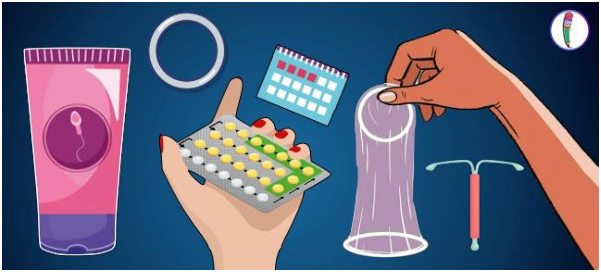
What is Contraception?
- It is the deliberate use of methods or techniques to prevent sperm from fertilizing an egg, or to prevent a fertilized egg from developing.
- People use contraception for various reasons: planning family size, spacing children, health reasons, or personal choice.
- Important Note: Some methods also help prevent the spread of Sexually Transmitted Infections (STIs), but many do not.
Methods of Contraception (with Advantages & Disadvantages)
There are many different methods. They work in different ways. It's important to choose a method that suits the individual or couple. Consulting a nurse or doctor (kuyenda kuchipatara kumbonopakurirwa ruzivo nana mazvikokota) is the best way to get advice.
1. Natural Methods
- How they work: Avoiding sex during the woman's fertile time (when she can get pregnant) or withdrawing the penis before ejaculation.
- Examples: Rhythm (Calendar) Method, Withdrawal (kudira panze).
- Advantages: No cost, no chemicals or devices, acceptable to some beliefs.
- Disadvantages: Not very reliable (can easily fail), requires careful tracking or strong self-control, does NOT protect against STIs.
2. Barrier Methods
- How they work: Physically block the sperm from reaching the egg.
- Examples:
- Male Condom (kondomu rechirume): A thin rubber sheath put on the erect penis.
- Female Condom: A pouch inserted into the vagina.
- Diaphragm/Cervical Cap: A dome-shaped cup placed over the cervix (entrance to the womb). Needs fitting by a nurse/doctor.
- Advantages: Condoms are readily available, protect against many STIs, no serious health side effects for most people.
- Disadvantages: Must be used correctly every time you have sex, can sometimes break or slip, diaphragm needs fitting and requires spermicide jelly.
3. Hormonal Methods
- How they work: Use artificial hormones (similar to the body's own) to stop the woman's body from releasing an egg (ovulation), or thicken cervical mucus to block sperm.
- Examples:
- Combined Pill / Birth Control Pill (piritsi rekudzivirira pamuviri): Taken daily.
- Progestogen-only Pill (Mini-pill): Taken daily.
- Injection (jekiseni reDepo-Provera): Given every 2 or 3 months.
- Implant (chitsvimbo/Norplant/Jadelle): Small rods put under the skin of the arm, lasts 3-5 years.
- Advantages: Very effective if used correctly, convenient (especially injection/implant), may make periods lighter or more regular for some.
- Disadvantages: Need a prescription or clinic visit, must remember to take pills daily, can have side effects (e.g., weight changes, mood swings, headaches, spotting - varies greatly between people), does NOT protect against STIs.
4. Intrauterine Devices (IUDs)
(pronounced “indra yu terin”):
- How they work: A small device (often T-shaped, made of plastic and copper, sometimes releasing hormones) placed inside the woman's uterus (chibereko) by a nurse or doctor. It stops sperm from reaching the egg or prevents the egg from implanting.
- Examples: Copper IUD ("Loop" - chibereko loop), Hormonal IUD.
- Advantages: Very effective, lasts for a long time (5-10 years depending on type), reversible (can be removed when pregnancy is desired).
- Disadvantages: Must be inserted and removed by a trained professional, can cause heavier periods or cramping initially (especially copper IUD), small risk of infection after insertion, does NOT protect against STIs.
5. Permanent Methods (Sterilization)
- How they work: Surgical procedures to permanently prevent pregnancy.
- Examples:
- Tubal Ligation (Female): The woman's fallopian tubes (where egg meets sperm) are cut or blocked.
- Vasectomy (Male): The man's sperm ducts (tubes carrying sperm) are cut or blocked. (Simpler and safer operation than female sterilization).
- Advantages: Permanent (no need to think about contraception again), very effective.
- Disadvantages: Intended to be irreversible (very difficult or impossible to undo), requires a surgical operation, does NOT protect against STIs.
Important Considerations:
- Effectiveness: Methods vary in how well they work. Permanent, hormonal, and IUD methods are generally the most effective when used correctly. Natural methods and withdrawal are the least effective.
- STI Protection: Only condoms (male and female) offer significant protection against HIV and other STIs.
- Health: Some methods may not be suitable for people with certain health conditions.
- Choice: The best method is one that the person or couple feels comfortable with, can use correctly, and fits their lifestyle and health needs. Always seek advice from healthcare workers!
Let's Summarise (Reproduction & Contraception)
- Asexual Reproduction in plants uses one parent, makes identical offspring (clones) quickly, via methods like runners, tubers, or cuttings. It lacks variety.
- Sexual Reproduction in plants uses flowers/seeds, involves two parents (or parts), creates variety, but is slower.
- Contraception is used by humans to prevent pregnancy.
- Methods include Natural, Barrier, Hormonal, IUDs, and Permanent.
- Each method has advantages and disadvantages regarding effectiveness, side effects, convenience, cost, and STI protection (only condoms do this well). Consulting health professionals is vital.
Topic: HEALTH AND DISEASES
Hello Students!
Our bodies are amazing! They have ways to protect us from germs (utachiona) and sickness. Today we will learn about this protection, called Immunity, and also discuss some serious diseases like HIV/AIDS and Malaria, and how we can protect ourselves and others.
Immunity - Our Body's Defence Force
What is Immunity?

Immune cells defending the body.
- Think of your body like a country. Sometimes, bad guys (germs like bacteria or viruses) try to invade and make you sick.
- Immunity is your body's ability to fight off these germs and protect you from the diseases they cause.
- It's like having soldiers (masoja) inside your body that recognize the enemy (germs) and destroy them before they can cause too much harm.
- If you have immunity to a certain disease, it means you either won't get sick from it at all, or you will only get a very mild sickness.
Types of Immunity
There are different ways our bodies get this protection. We can think about it in two ways: How we get it (Natural vs Artificial) and How it works (Active vs Passive).
Let's combine these:
1. Natural Active Immunity:
- How you get it: You get sick with a disease (e.g., chickenpox - gwirikwindi diki).
- How it works: Your body fights the germs and learns how to defeat them by making its own special soldiers (called antibodies).
- Result: You usually have long-lasting protection and won't get that same sickness again. Your body actively made the defence.
2. Artificial Active Immunity:
- How you get it: You get a Vaccination (jekiseni rekudzivirira chirwere) at the clinic (kuchipatara). The vaccine contains a dead, weakened, or parts of the germ.
- How it works: The vaccine safely triggers your body to learn and make its own antibodies (soldiers) against that specific germ, just like if you had the real disease, but without making you seriously sick.
- Result: You get long-lasting protection without having to suffer the actual illness. Your body actively made the defence because of medical help (artificial).
3. Natural Passive Immunity:
- How you get it: A baby gets ready-made antibodies (soldiers) directly from the mother. This happens:
- Before birth, across the placenta.
- After birth, through breast milk (mukaka waamai), especially the first milk (colostrum).
- How it works: The baby receives protection without its own body having to make it yet. The baby is passive - just getting the help.
- Result: Gives the baby temporary protection against diseases the mother is immune to, while the baby's own immune system develops. It doesn't last forever.
4. Artificial Passive Immunity:
- How you get it: You receive an injection (shot) of ready-made antibodies that were produced by another person or animal. This is sometimes given if you've been exposed to a dangerous disease (like rabies or tetanus) and need protection immediately.
- How it works: You are given the soldiers directly. Your body is passive.
- Result: Gives immediate, but temporary protection. Your body didn't learn how to make its own soldiers for this.
How Infants (Babies) Acquire Immunity
As we just learned, babies get Natural Passive Immunity:
- From the Mother Before Birth: Antibodies pass from the mother's blood to the baby's blood through the placenta while the baby is in the womb (mudumbu).
- From Breast Milk After Birth: Antibodies are present in breast milk. When the baby drinks the milk, these antibodies help protect the baby's insides (like the stomach and lungs) from infection. The first few days' milk (colostrum) is especially rich in these antibodies.
This protection is very important because a baby's own immune system is still learning and developing. Breastfeeding helps keep babies healthy!
HIV/AIDS
HIV stands for Human Immunodeficiency Virus.
AIDS stands for Acquired Immunodeficiency Syndrome. HIV is the virus that causes AIDS.
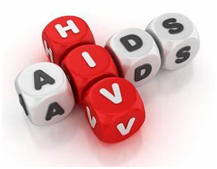
How HIV/AIDS is Spread (Transmission)
HIV is found in certain body fluids of an infected person: blood, semen (urume), vaginal fluids, and breast milk. It can only be spread in a few main ways:
- Unprotected Sexual Intercourse: Having sex (vaginal, anal, or oral) without using a condom (kondomu) with someone who has HIV. This is the most common way it spreads.
- Sharing Infected Needles or Syringes: Sharing equipment for injecting drugs, or using unsterilized needles for injections or traditional cuttings/tattooing.
- From Mother to Child: An infected mother can pass the virus to her baby during pregnancy, childbirth, or breastfeeding. (BUT, this risk can be greatly reduced with proper medical care!).
- Infected Blood Transfusion: Receiving blood that has HIV (this is now very rare in countries like Zimbabwe where blood is tested).
HIV is NOT spread by:
- Touching, hugging, shaking hands
- Sharing food, plates, cups, or toilets
- Mosquito bites or other insects
- Sneezing or coughing
- Swimming pools
Knowing how it spreads helps us protect ourselves and stops unfair treatment (stigma) of people living with HIV.
Effects of HIV on the Body
- HIV attacks the body's immune system. Remember the soldiers (antibodies and white blood cells) that fight off germs? HIV attacks and destroys the most important of these soldiers (specifically, CD4 or T-cells).
- As HIV destroys more immune cells, the body becomes weaker and weaker. It becomes difficult for the body to fight off other infections and cancers.
- These other infections are called Opportunistic Infections (like TB - tibhii, pneumonia, certain skin cancers) because they take the opportunity of the weakened immune system to cause sickness.
- AIDS is the late stage of HIV infection when the immune system is severely damaged, and the person gets serious opportunistic infections or cancers.
How the Spread of HIV/AIDS Can Be Controlled (Prevention)
We can all help stop the spread of HIV!
- Abstinence: Choosing not to have sex.
- Be Faithful: Having sex with only one partner who is also faithful and HIV-negative.
- Condom Use: Correctly and consistently using condoms during sexual intercourse significantly reduces the risk.
- Avoid Sharing Sharp Objects: Do not share needles, syringes, razors, or anything that might have blood on it. Ensure medical injections use sterile needles.
- Testing and Counselling (VCT): Knowing your HIV status helps you make informed decisions to protect yourself and others.
- Treatment as Prevention (TasP): People living with HIV who take their ARV (Antiretroviral) medication correctly every day can lower the amount of virus in their body so much that they cannot transmit it sexually.
- Prevention of Mother-to-Child Transmission (PMTCT): Pregnant women with HIV can take ARV medication to greatly reduce the chance of passing the virus to their baby.
- Blood Safety: Ensuring all blood used for transfusions is tested for HIV.
- Education and Awareness: Understanding how HIV spreads and how to prevent it empowers everyone.
Malaria
Malaria (marariya) is a serious disease common in many parts of Zimbabwe, especially during the rainy season. It's caused by a tiny parasite, not a virus or bacteria.
Life Cycle of the Malaria Parasite

Life cycle of the Malaria Parasite.
The malaria parasite needs two hosts to complete its life cycle: a specific type of mosquito (Anopheles) and a human.
- Mosquito Bites Infected Person: A female Anopheles mosquito bites someone who already has malaria parasites in their blood. It sucks up the parasites along with the blood.
- Parasite Develops in Mosquito: Inside the mosquito's body, the parasites multiply and develop over about 10-14 days (depending on temperature). They travel to the mosquito's salivary glands (where its "spit" comes from).
- Infected Mosquito Bites Healthy Person: The infected mosquito bites another person. As it feeds, it injects the malaria parasites into the person's blood along with its saliva.
- Parasites Go to Liver: The parasites travel through the bloodstream to the person's liver.
- Parasites Multiply in Liver: Inside the liver cells, the parasites multiply rapidly for several days or weeks, but the person doesn't feel sick yet.
- Parasites Enter Red Blood Cells: The parasites leave the liver and enter the person's red blood cells.
- Parasites Multiply in Red Blood Cells: Inside the red blood cells, the parasites multiply again. Eventually, they cause the red blood cells to burst open, releasing lots of new parasites.
- Symptoms Appear: The bursting of red blood cells releases toxins and causes the typical symptoms of malaria: fever (kupisa muviri), chills (kubanda), sweating, headache, muscle aches, and feeling very unwell. This cycle of parasites multiplying and bursting red blood cells repeats every 2-3 days, causing cycles of fever.
- Cycle Repeats: Some of the parasites released develop into special forms that can infect mosquitoes. If another Anopheles mosquito bites this person now, it will pick up these forms, and the whole cycle starts again (Step 1).
Methods of Controlling Malaria
We can fight malaria by targeting the mosquito, the parasite, or protecting people.
- Preventing Mosquito Bites:
- Insecticide-Treated Nets (ITNs): Sleeping under a mosquito net treated with insecticide every night is very effective.
- Insect Repellents: Using creams or sprays on skin that keep mosquitoes away.
- Protective Clothing: Wearing long sleeves and trousers, especially during early evening and morning when mosquitoes are most active.
- Screening Windows and Doors: Putting mesh screens on openings to keep mosquitoes out of houses.
- Controlling Mosquito Populations:
- Indoor Residual Spraying (IRS): Spraying insecticides on the inside walls of houses, where mosquitoes rest after biting.
- Larviciding / Eliminating Breeding Sites: Mosquitoes lay eggs in stagnant (still) water. Getting rid of puddles, old tyres, blocked drains, and containers holding water near homes reduces places for mosquitoes to breed. Sometimes chemicals are put in water bodies to kill the larvae (young mosquitoes).
- Early Diagnosis and Treatment:
- Testing: If someone has symptoms, getting tested quickly (kuchipatara) to confirm if it's malaria.
- Effective Medicines: Taking the correct anti-malarial drugs prescribed by healthcare workers immediately after diagnosis kills the parasites in the blood and cures the person, also preventing them from spreading it further.
- Community Education: Teaching people about how malaria spreads, how to prevent bites, recognize symptoms, and the importance of seeking treatment quickly.
Let's Summarise (Health and Diseases)
- Immunity is the body's defence against germs. It can be Active (body makes defence) or Passive (body receives defence), and Natural (from infection/mother) or Artificial (from vaccine/injection). Babies get Natural Passive Immunity from their mothers.
- HIV attacks the immune system, making people sick from other infections (AIDS is the late stage). It spreads through unprotected sex, infected blood/needles, and from mother to child. It is controlled by Abstinence, Being faithful, Condoms, Testing, Treatment (ARVs), and preventing mother-to-child transmission.
- Malaria is caused by a parasite spread by Anopheles mosquitoes. The parasite develops in the mosquito and human (liver, then red blood cells). It's controlled by preventing bites (nets), killing mosquitoes (spraying, removing stagnant water), and early testing and treatment with medicine.
